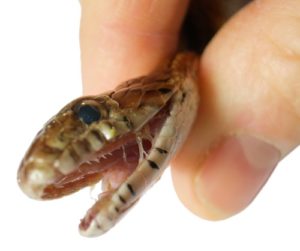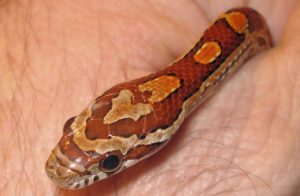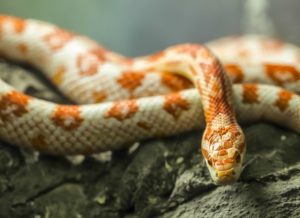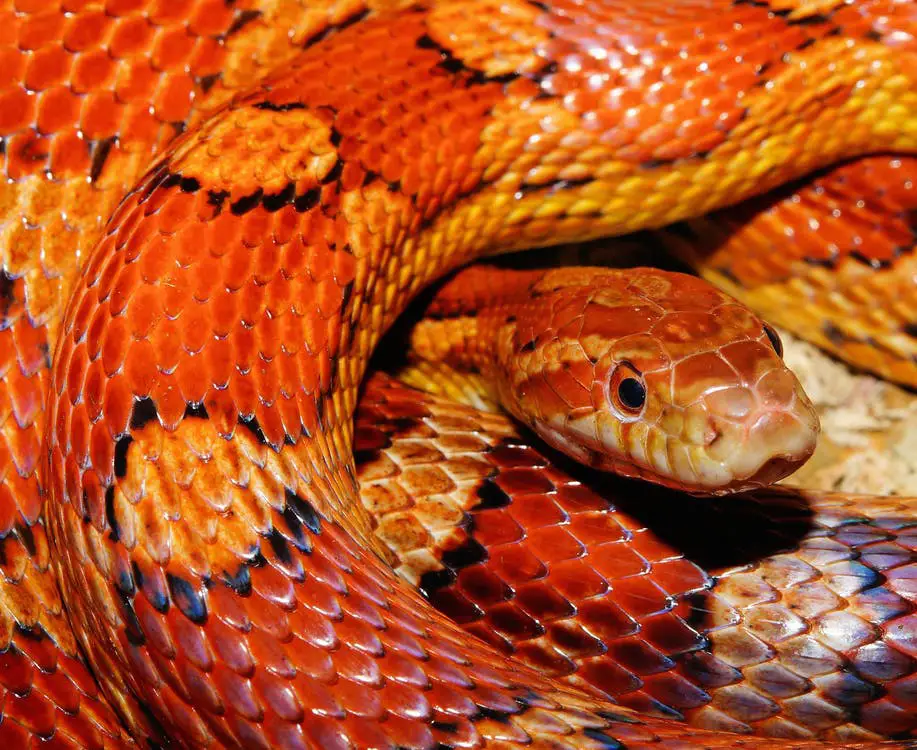There are some animals that make for unique and interesting companions. Reptiles fall into this category. In this article, we will talk about the corn snake. Recognized for its’orange back and the black stripes that run down it, they come in a variety of patterns and colours.
If you are thinking about getting a corn snake as a pet you may be wondering if they is a chance of getting bit. More importantly you may also be wondering how bad a corn snakes bite actually is! Well we are going to tell you as well as teach you how to reduce the chances of a bite through safe handling techniques.
You may also want to know if ball pythons bite.
Do corn snakes bite?
For those that have come here for the straight answer and do not want to know how to avoid a bite I will give you the quick answer. Hopefully it will not put you off owning a corn snake as they are amazing animals to keep.
So do corn snakes bite? The quick answer is yes. Corn snakes can and do bite. Thankfully corn snakes do not possess venom and as such their bite is relatively danger free. They do have teeth though so they can give you a nasty shock and nip but with good handling techniques this chance can be heavily reduced.
Please read on to learn more about corn snake bites and safe handling.
Does a corn snake bite hurt?
Snake bites are a cause of concern for people around the world. With the corn snake, however, pet owners have absolutely nothing to worry about. Juvenile snakes have small teeth, so their bite is completely harmless. As for adult snakes, their bite may feel like you’ve been pricked with a pin. There may be a drop or two of blood but is all in all uneventful.
Even though a corn snakes bite does not hurt it is still best to learn safe handling techniques. This is because if a corn snake does bite you it has been stressed or feels threatened and this is not good for the snake.

Do corn snakes bite? Even though corn snakes do not inject venom their teeth can give a painful bite
What causes a corn snake to bite?
Do corn snakes bite, what is the cause? There are quite a few reasons why a corn snake may last out at its owner and bite. Below is a few of them that you could possibly come across.
Provocation and fear.
The corn snake, as discussed earlier, is not malicious. However, they can feel threatened or scared. They will express this through their body language. When this happens, their head will be in retracted. Their neck is above the ground and in a shape that resembles the letter S. This is called the striking position. They will only use biting as a last resort defensive mechanism.
Other signs to look out for are hissing. They do not want to be held at this time. To scare away a perceived predator, they may rattle their tail or defecate on the owner during manipulation. You may want to wait a few days before attempting to hold the corn snake again.
The wrong approach when picking the snake up.
A typical predator’s behavioural patterns dictate an approach towards the snake from above. Although likely bred and raised in captivity, your pet is still governed by animal instincts. Its’ natural response is fear and it will react accordingly.
Hunger
Do corn snakes bite, because they are hungry? If it’s been a while since it hasn’t eaten, they will be hungry. With nature’s law of survival of the fittest, the corn snake might bite if they assume you are trying to take its’ food.
An injury or potential illness
When a snake is experiencing pain, discomfort or is sick, they are not feeling their best. They may bite because of this.
A traumatic past
Do corn snakes bite, because of trauma? Some animals that haven’t been well taken care of by their previous owner can show signs of distress. This is also true with the corn snake. If they weren’t manipulated properly or lived in an unsuitable environment, they can develop a fear of humans.
Was not bred in captivity
A corn snake that is taken out of its’ natural habitat may find it stressful to adapt to its’ new living quarters. Being in unfamiliar surroundings will make your pet nervous and more prone to biting.
Here is what to do if a corn snake bites you.
If you do get bitten by a corn snake, it might take you by surprise. You may have the reflex of immediately yanking your hand away. This may be difficult, but please refrain from doing so. The snake might have a tight grip and not let go. However, removing your hand like this will only make things worse.
Do corn snakes bite, is it painfull? You will feel pain. Since the corn snake’s teeth are angled back, it will tear your skin. As for your pet, they risk losing their teeth. The most effective way to resolve this is to pour a glass of cold water over the snake’s head. If that doesn’t work, you can also try pouring drinking alcohol.
The corn snake’s teeth are fascinating to study. Their mouths hold anywhere between 20 to 30 of them. There are four top rows aligned on one side of their jaw and two bottom ones. They look like barbed wire and are designed that way for a purpose. It gives them a strong grasp on their prey when they are constricting their bodies. It also ensures that their meal doesn’t escape. Their teeth aid in digestion, too. Unlike other animals, the corn snake cannot chew. As a result, your pet’s teeth serve as the driving force for swallowing their prey.
Do corn snakes bite, should you wash it? Of course, like any other bite, it is best to wash it. Traditional cleansing with soap and water will suffice. Also, it is recommended that you disinfect the wound with products like hydrogen peroxide or Neosporin. That’s because there is quite a bit of bacteria in the snake’s mouth.
How Can corn snakes be handled safely?
Do corn snakes bite? Keep yourself safe. It is best to take things slowly. It will take some time for your corn snake to get used to its’ new living environment. Wait until they are feeling more relaxed when placing them into their enclosure. This reinforces positive behaviour and will form good habits when handling them. When first welcomed home, it is recommended to wait two weeks before starting to handle the snake on a regular basis.
This would be a few times a week, but only once a day. Verify their eating patterns and make sure they are ingesting food regularly. Then, you can gradually increase the amount of time spent with the corn snake. Five minutes is a good start. It is important that this does not exceed an hour, or the corn snake’s body temperature will get too cold.
As you manipulate your pet, you’ll want to keep in mind a few things. Place your hands at 1/3 and 2/3 of the snake’s length, respectively. This will offer a good support and both owner and pet will be comfortable. Movements should be slow, gentle and steady.

Corn snakes are quite a small species of snake.
How to tame a corn snake.
One might not always know where to start when it comes to taming their pet. Here are some things to think about when welcoming them into your home. Do corn snakes bite when they are tame? No, they won’t bite when they are tame.
A controlled environment
This can be arranged with minimal effort on the owner’s part. A room that is clear of furniture would be best. This will prevent the snake from slithering away into potential hiding places. The area should also be free of pets and other people that the snake might view as threats. And lastly, one might want to put away any objects that are prone to sudden movements, like children’s toys.
Equipment to handle corn snakes.
- A snake hook or tongs: These will help you lift and gently grab the corn snake when wanting to take it out or put it back into its’ enclosure. There is a lot of discussion in the snake-handling community as to which of the two are better for the snakes. Both have their advantages. The snake hook offers the corn snake more freedom to move. Tongs are wrongly accused of crushing snakes, but that is a myth. It offers users a stronger level of control and a better grip of the animal, which makes the manoeuvre quicker.
- A snake bag can be practical for carrying the snake from the room to its’ vivarium. When shopping for one, you will want to choose a bag that will be a comfortable fit for your pet. That way, it won’t squirm.
- An owner may feel more confident in manipulating their pet if they are wearing sturdy gloves. A leading brand that manufactures these is HexArmor with the Hercules 400R6E bite-proof glove. They can resist punctures from snake teeth and offer great flexibility for hand movement.
- When all else fails, one can refer to restraint equipment. This is mainly if the snake is acting aggressively or isn’t being cooperative. This generally is plastic tubing that is transparent in appearance.
All of these will likely no longer be necessary once the corn snake is used to its’ owner.
The right time to handle a corn snake.
There are three instances when it would be preferable to avoid handling a snake.
- Within the first 48 hours that it’s been fed: It takes the corn snake between 48 and 72 hours to digest what they’ve eaten. Manipulating them before then can cause them to regurgitate their food and even be the cause of their death.
- Before and during shedding: Moulting is an unpleasant and uncomfortable time for the snake. Their eyes’ appearance changes to a colour resembling blue. Their gaze is somewhat cloudy. As they are unable to see, they are naturally more on the defensive when confronted with sudden movements or touch.
- When the corn snake is still a hatchling: Their behaviour is unpredictable, and they get nervous rather easily.

Do corn snakes bite? Corn snakes do not posses venom as they are constrictor snakes.
Do corn snakes make good pets?
The corn snake is an excellent choice of pet. This is especially true for beginners. Several factors explain the snake’s popularity with first-time owners and experienced ones alike. Below I have listed some of the reasons why a corn snake is a good choice of pet for anyone looking to get into the care of snakes.
Care and maintenance
People appreciate the relative simplicity of caring for them. Of all the varieties of snakes that are bred in captivity, this one is low maintenance. There is a certain extent of flexibility in choosing the ideal habitat for it to live in. The vivarium must be twenty gallons and have a mesh lid that locks securely. However, one can choose between materials such as wood, glass or plastic. As they aren’t very social creatures, it is best to have one snake per enclosure.
To make a snake feel at home, be sure to include a few hiding places. These should be just big enough for them to curl up in. Unlike many snakes, they do not need a UV light. That is because they are nocturnal. It is recommended, though, to place a snake’s vivarium in indirect light. This will help the snake differentiate the night from the day and identify different season cycles.
In terms of heat, the pet corn snake’s vivarium should be between 70 to 85 degrees. Heat lamps can be useful in maintaining this temperature. They have practical features like a timer and are adjustable.
Humidity is another important factor in planning a good environment for your pet. For a good hydration and an easy shedding of their skin, a 40% to 50% level of humidity is recommended.
Non-venomous
The corn snake does not present any danger whatsoeverto its’ owners. This is the big difference between snakes with fangs and those with teeth. Fangs inject poison, whereas teeth serve for digestion. Corn snakes have teeth.
A docile disposition
Known for being a generally docile animal, it is patientand tolerates being handled. There is no noticeable difference in temperament between the male and female corn snake.
Conclusion
Do corn snakes bite?To conclude, the corn snake is a great pet choice for first-time owners and beginners. They are easy to care for, are safe to have in the home and have a docile nature. Taming them can be an adaptation. However, things will go well if you have the right equipment and have a good sense of timing.
With time and patience, handling them can become a rewarding experience. There may be causes for them to bite but knowing what these factors are can reduce the chances of this happening. If they do bite, it is generally harmless and will be quick and over with if dealt with properly.
